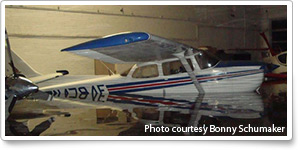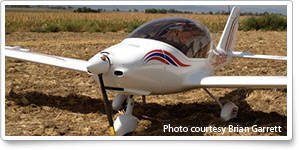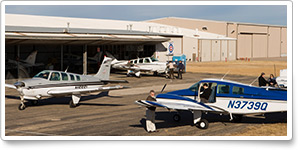| ||||||
| Supersonic twist |
| |||||
| Click here for this week's custom content. | |
FeaturedSupersonic twist | |
GA NewsA solemn anniversary, marked by progressSome wounds of 9/11 may never heal, but the passage of time—and ongoing vigilance—has helped the nation, including its pilots, recover from the chaotic aftermath of the infamous attacks. The general aviation community joins all Americans in marking this solemn anniversary, grateful that freedom to fly was not among the casualties, though there is still work to be done to ensure that precautions taken are sensible and effective. Read more >> Best-selling author injured in aircraft accidentPilot and author Richard Bach remained in serious condition after his aircraft crashed while he was attempting to land in Washington state, according to media reports. The amphibious aircraft came to rest inverted in a field Aug. 31 after clipping a power line on approach to landing at a grass strip, his son James Bach told The Associated Press. Read more >> New Orleans aircraft owners seek answers after flood Cessna leads amped-up LSA registration raceFlight Design still leads the light sport aircraft market in total number of aircraft registered—but competitor Cessna Aircraft Co. is nipping at its heels, with 71 light sport aircraft registered in the first six months of 2012. Read more >> Lost prop on checkride: Did he pass? Enter the Solo Hall of FameThe time-honored practice of cutting student pilot shirt tails after their initial solo flights is getting a digital-age upgrade that’s easy to share. NFlightcam is launching a program that allows student pilots to record their initial solo flights free on an NFlightcam, send them to the company for editing, and share the finished products via email, YouTube, and Facebook. Read more >> Will LSAs make passing grade?Dan Johnson, president of the Light Aircraft Manufacturers Association, says the FAA will begin three-day field audits of light sport aircraft (LSA) manufacturers starting in March 2013. The plan was briefed to the LSA industry during EAA AirVenture 2012. The emphasis will be on those manufacturers introducing new models. Read more >> Low-time Cessna 182 gets outback makeoverIf someone donates a 1974 Cessna 182P with only 800 hours on it, why would it need to be rebuilt? Because you can't take any risks with the outback of Australia, where it is headed for missionary work. There's little civilization along the routes to Aboriginal communities. Read more >> Smith to lead AOPA Center to Advance the Pilot CommunityAOPA has named Adam Smith as senior vice president of its forthcoming Center to Advance the Pilot Community. The center was created to stop the slow, steady decline in the number of certificated pilots in the United States and to seek ways to stimulate growth. AOPA and the AOPA Foundation are showing their commitment to rebuilding the pilot population by creating this entirely new division to be staffed with experts on research, building communities, and continuous learning to help guide the center’s work. Read more >> NASA mission could help protect GPSNASA has launched a two-year effort to learn how better to predict the behavior of the Van Allen radiation belts that circle Earth, behavior that can at times threaten GPS and other satellite communications. Two satellites are orbiting through the belts of highly charged particles that protect the planet from solar storms and “space weather.” Read more >> Analysts see signs of aircraft market recoveryWith deliveries picking up, there are signs of hope for the suffering aircraft market—particularly business jets. Analysts say that sustained recovery will depend on renewed demand from North America, and there are signs it is coming. The piston market, however, may be another story. Read more >> Gulfstream 280 certified in US and IsraelThe Gulfstream Aerospace G280—formerly the Astra Galaxy, then the Gulfstream G200, and then modified to become the G250—has received type certificates in the United States and Israel. The number designation was changed after it was discovered that the number 250 in Mandarin can mean "imbecile" or "foolish" and might limit sales in Asian markets. Read More >> | |||||||||||||||||||||||||||||||||||||||||||||||||
Flight Instructor Refresher Clinics | Air Safety Institute Safety Seminars | |||||||||
For a complete schedule, see AOPA Online. Can’t make it in person? Sign up for the CFI Refresher Online. |
Topics vary—for details and a complete schedule, see AOPA Online. | |||||||||
AOPA Aviation Summit
Top five reasons to catch AOPA’s Parade of Planes
AOPA’s Parade of Planes returns after six years. Watch as dozens of aircraft taxi under their own power from Palm Springs International Airport to the Palm Springs Convention Center on Oct. 10. Here are the top five reasons you won’t want to miss this parade. Read more >>
Advance Summit registration ends Sept. 14
Don’t miss out on AOPA’s popular Parade of Planes, hours of educational and safety seminars, hundreds of exhibits, and social events in sunny Palm Springs, Calif., Oct. 11 through 13. Take advantage of advance savings by registering before Sept. 14. Learn what registration packages are available and sign up today.
Watch unveiling of hottest aviation products
Don’t wait to read about the newest products on the market. Get the latest on the new products live as they are being announced and demonstrated at AOPA Aviation Summit. New products will be announced each day in the Palm Springs Convention Center’s Interactive Lounge—open to all attendees with an exhibit hall pass.
‘Airports Day’ offers tips and tools for advocates
From national policies to lease agreements, a variety of airport issues affect your freedom to fly. That’s why AOPA has dubbed Oct. 12 “Airports Day” at AOPA Aviation Summit, dedicating a new seminar track to informative sessions designed for airport managers, leaders, and advocates. FAA Deputy Associate Administrator for Airports Catherine Lang will give an inside view on issues important to your home field in “FAA Airports—News from the Top,” at 10:30 a.m. At 1:30 p.m., advocates can learn how to minimize conflict, maximize communication, and foster support for their airport in “Managing Airport Relationships.” And airport managers can learn about resources available to them in “The Airport Manager’s Toolkit” at 3:15 p.m. View a complete schedule online.
ADVOCACY
Sept. 14 deadline nears on AOPA-EAA medical petition
Fly the most accessible recreational aircraft—single-engine aircraft with 180-horsepower or less, four seats or fewer, and fixed landing gear—with less medical hassle. Submit comments in support of the AOPA/EAA medical exemption today!
Cellphones, GA ops excluded from FAA electronics study
The FAA will soon convene a study group to take a fresh look at in-flight use of portable electronic devices on airlines. In conversations with AOPA staff, agency officials confirmed the study—which has potential to expand the use of iPads and similar devices on commercial flights—will not include general aviation use of the devices, but focus exclusively on airline passenger use. Read more >>
Airport safety management a matter of scale
A culture of aviation safety has broad industry support. But requiring general aviation airports to implement safety management systems based on programs at commercial-service airports would impose crippling burdens on the smaller facilities, AOPA said in a regulatory filing. Read more >>
FAA responds to users on future navigation system
As the FAA begins to detail plans to take the National Airspace System from ground-based navigation systems to satellite technology, the agency has committed to creating an advisory group urged by AOPA and others to help set key guidelines for the transition. Read more >>
Member Benefits
AOPA membership drive: Member get a member
AOPA’s “Strength in Numbers” membership drive is under way, with AOPA members working to help recruit new pilots, aircraft owners, and aviation enthusiasts. Have you recruited any new members yet? If not, check out these top three reasons why you should. Read more >>
 Frequent headaches?
Frequent headaches?
Pilots must answer whether they have a history of “frequent or severe headaches” on their medical application. But what, exactly, constitutes a frequent or severe headache? Are three headaches a month frequent, or three a year? How do we determine severity? On a scale of one to 10, which is how your doctor would normally ask you to gauge the pain? Or how often you have to take medications to stop the headache? Find out what the FAA says in this latest installment from AOPA’s Pilot Protection Services. Read more >>
Testing the limits
How would your insurance shake out after an emergency landing on a golf course that injures your passenger and a golfer, tears up the fairway, and damages your aircraft? Read more >>
AOPA Career Opportunities
Ever dream of turning your passion for aviation into a career? We’re looking for a director of legislative affairs, director of media relations, major gifts officer, accounts payable technician, administrative coordinator, aviation technical generalist, and Web graphic designer. To learn more about other AOPA career opportunities, visit AOPA Online.
Community
Picture PerfectAOPA’s online photo gallery allows you to upload your own aviation photography as well as view, rate, and comment on others’ photos. Your favorite aviation images from AOPA Pilot are still available online through this new gallery. Take a look, and submit your own photos! | | |
Engage in AviationCheck out user-submitted events from your region. To include an event or to search all events in the calendar, visit AOPA Online. AOPA does not endorse the events listed below, nor have ePilot editors edited the submissions. AOPA assumes no responsibility for events listed.
| |
| |
QUIZ ME!Here’s a question asked by an AOPA member who contacted our aviation services staff through the AOPA Pilot Information Center. Test your knowledge.
Question: How long do I have to regain IFR currency by completing the required instrument approaches before I must perform an instrument proficiency check (IPC)?
Answer: The FAA recently issued a clarification to the instrument currency requirements that has created some confusion on this topic. However, the rule remains the same in that a pilot still has one year to regain currency prior to completing an IPC.
FAR 61.57(c) allows a six-month currency period and then six additional months in which a pilot can complete the currency requirements without having to take an IPC.
Here’s an example: A pilot fulfilled the IFR currency requirements on July 31, 2012. He is current for IFR flight until Jan. 31, 2013. After Jan. 31, 2013, the pilot would have until July 31, 2013, to, again, complete the currency requirements. If currency requirements were not met before July 31, 2013, an IPC would be required.
This excerpt from the Federal Register further clarifies the rule:
Got a question for our aviation services staff? The AOPA Pilot Information Center is a service available to all members as part of the annual dues. Call 800/USA-AOPA (800/872-2672), or email to [email protected]. |
| |
| |
| |
| | ||||
| ePilot Editor: | Contributors: | | Production Team: | Advertise in ePilot: |
| Member Tools: Send feedback | ePilot Archive © 2012 Aircraft Owners and Pilots Association | 421 Aviation Way Frederick, MD 21701 | Phone 800/USA-AOPA | Fax 301/695-2375 | ||||













